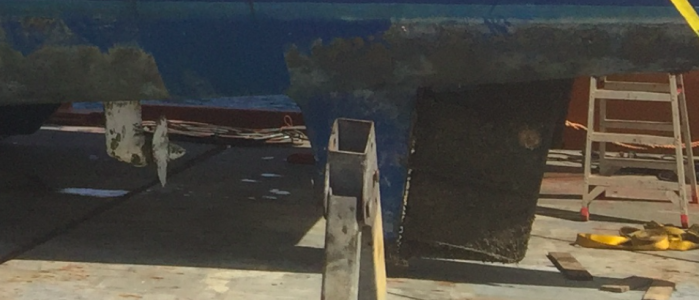Trident
Well-known member
I have a 50ft catamaran withs keg hung rudders - Prout Quasar
At some point in the past the original fibreglass rudders must have died - probably water in the foam - and the previous owner decided to make a stainless plate as his new rudder - I assume on the original rudder stock, just 5mm plate cut to the same shape as the original rudder in profile, and with some webs at 90 degrees to the plate to provide more strength . It certainly turns the boat and being solid stainless is probably a good thing in orca alley but..
She's coming out in spring for a paint job and at the same time I'm changing the link bar between rudders (as this means cutting a hole in the side to remove it and best done before the paint) and this got me thinking about making up new rudders whilst I'm at it.
I'm thinking a carbon stock with torque tabs securing it to a foam core and a few layers of glass - all done with epoxy and completely sealed so as never to get water in the foam.
My question is this - with a skeg hung rudder how much difference will the shape make ? I think, that compared to blade designs they are inefficient anyway (but may or may not be safer but its what I have so that makes no odds) but I assume some aerofoil shape will improve on the flat plate I have but , should I pay a designer to come up with the shape (at no doubt some considerable cost) or should I just do my best to copy the shape of the originals from photos etc and make a generally even wing shape across the known height and width (and leading edge thickness is quite guessable from the trailing edge of the skeg) ? How much difference will it really make on a fast but cruising cat from 40 years ago? (15-18 knots , 8-9000 kg)
Any thoughts please
At some point in the past the original fibreglass rudders must have died - probably water in the foam - and the previous owner decided to make a stainless plate as his new rudder - I assume on the original rudder stock, just 5mm plate cut to the same shape as the original rudder in profile, and with some webs at 90 degrees to the plate to provide more strength . It certainly turns the boat and being solid stainless is probably a good thing in orca alley but..
She's coming out in spring for a paint job and at the same time I'm changing the link bar between rudders (as this means cutting a hole in the side to remove it and best done before the paint) and this got me thinking about making up new rudders whilst I'm at it.
I'm thinking a carbon stock with torque tabs securing it to a foam core and a few layers of glass - all done with epoxy and completely sealed so as never to get water in the foam.
My question is this - with a skeg hung rudder how much difference will the shape make ? I think, that compared to blade designs they are inefficient anyway (but may or may not be safer but its what I have so that makes no odds) but I assume some aerofoil shape will improve on the flat plate I have but , should I pay a designer to come up with the shape (at no doubt some considerable cost) or should I just do my best to copy the shape of the originals from photos etc and make a generally even wing shape across the known height and width (and leading edge thickness is quite guessable from the trailing edge of the skeg) ? How much difference will it really make on a fast but cruising cat from 40 years ago? (15-18 knots , 8-9000 kg)
Any thoughts please

